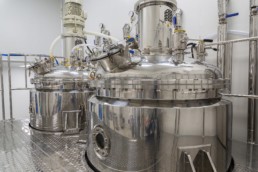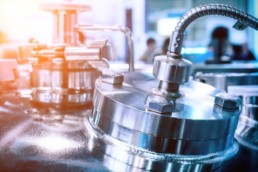In the chemical manufacturing industry, we have been searching for the keys to unlock the future for many decades. In a reality where we are increasingly aware of the effects of our activities on the environment, as well as significantly more careful about potential health issues, the goal is to create safer and more efficient chemical products and materials that can ensure the best results for both our customers and the world surrounding them.
Manufacturers have invested billions in studying advanced versions of traditional chemistries, such as surfactants – biosurfactants – solvents, polymers, and antimicrobials, among others, and interesting results have been achieved. These studies have led us to now create safer cleaning agents, more effective agrochemicals, high-yield solvents, and stronger polymers than ever, and it looks like the trend will continue.
However, there is a type of chemical that holds the most potential and which might be the solution to creating bio-based advanced intermediate chemistries, the building blocks required to construct the next stage of green chemical products. I’m talking about catalysts – the path to an environmentally friendly future of chemistry.
Why the new age of chemistry will belong to catalysts
A catalyst is defined, simply, as “a substance that enables a chemical reaction to proceed at a usually faster rate or under different conditions than otherwise possible”, but they represent much more than this alone for the chemical industry.
For example, the simple act of cracking – the reaction in which larger saturated hydrocarbon molecules split carbon-carbon bonds of alkanes and alkenes – requires a tremendous amount of energy (pressure and temperature), but catalysts can offer a shortcut towards achieving the desired atomic topology with added functional properties. To make simple materials of daily use, such as glass, plastics, and elastomers, not to mention the breaking of bonds present in other organic chemistries, you will also need equipment to operate at significant pressure and temperature levels, or you may find that undesired side-effects occur on the final quality of the products obtained.
By adding catalysts into the vessels being used for our chemical reactions (or reactors, for short), we can significantly lower the energetic levels required for the reaction to occur, using these molecules to speed up the reaction and create intermediates at safer conditions than previously. In other words, catalysts can lead a chemical plant past previous obstacles with ease, whether they are of an economical or technological nature.
Furthermore, by leveraging the power of catalysts with modern technology, such as the immensely advanced high throughput screening techniques that are arriving at chemical labs with the age of Industry 4.0, we have a recipe for making immense leaps in terms of technical achievements.
The magic of catalysis and what it brings to the industry
Catalysts are divided into three types: heterogeneous catalysts, homogeneous catalysts, and biocatalysts (or enzymes, which I will discuss in a future post).
Heterogeneous catalysts are those mostly associated with the potential for the creation of advanced intermediates, since, unlike homogeneous catalysts (which are found in the same phase as the reaction mixture – typically gas or liquid – and are typically difficult to separate from the final products), heterogeneous catalysts perform at harsher conditions, are easier to extract from the products obtained, and are also simpler to recycle.
For a heterogeneous catalyst to accelerate a chemical reaction, there must be contact between the catalyst’s active sites (the atoms on the catalyst where the reactions occur) and the reacting molecules. Despite being complicated to study, these active sites and the nature of their interaction with chemical reactants is where all of the magic occurs.
Heterogeneous catalysts (typically platinum, nickel, vanadium or zeolites) act through a process of adsorption: reactant molecule “A” collides with one of the catalysts’ active sites, adsorbing into this space until another desired reactant – “B” – makes contact with the catalyst and pulls “A” away to form a completely new molecule, “AB”. In this sense, the catalyst is the medium which allows collisions to occur more frequently, while having the advantage of not directly intervening with the reaction itself.
This means that catalyzed reactions require less external energy to be introduced into the system for increased collisions (usually achieved by raising the pressure and temperature), and can allow manufacturers to introduce more delicate elements into the reaction, such as biological materials, that will ensure a green hybrid product is obtained. In turn, this enables us to approach more acceptable levels of sustainability with renewable ingredients. A win for all sides, it must be said.
Modern catalysis processes – keeping them economically viable
As excited as we may be by the products created with catalyzed reactions, the processes and technology involved must also be safer and more cost-efficient, or the interest in using them will vanish.
In this sense, when talking of the current batch (stirred batch reactors, to be precise) and semi-continuous technologies, there is a lot which can still be improved in terms of viability.
For example, microwave technologies are being introduced to reactor systems, both as a means of heating and increasing diffusion efficiency, and both fluidized and packed bed reactors are gaining more usage as companies seek to optimize their processes towards higher-converting reactors. It is also clear that batch reactors are slowly being phased out for continuous technologies, which were previously most often used for the production of fine chemicals.
In the end, the economics that surround catalysis revolve around three main parameters: conversion, selectivity and yield.
- Conversion involves the amount of reactant being consumed, by the amount of reactant being introduced to the system – the ideal conversion rate of a reactor is based on 1, but this is not possible in reality;
- Selectivity revolves around the ratio of the desired product formed to the undesired product that is formed – processes which create high amounts of byproducts are undesirable due to unnecessary expenses;
- Finally, yield refers to the amount of a specific product that is formed per mole of reactant consumed and can also be expected to be between 0 and 1.
If these parameters can be kept in control, working hard to evolve not only the catalysts and technologies but also the processes used to produce new chemistries – optimizing them by using advanced simulation technologies and high throughput screening automation – the next step of renewable chemistry will practically be around the corner for our industry.
How Environmental Fluids is harnessing catalysis for a green future
As a company looking to provide solutions to companies wishing to go green and create cleaner, safer chemistries, Environmental Fluids has been forming key partnerships with manufacturers creating coatings and cleaning products; working alongside personal care companies to protect the health of their customers; and bringing important answers to industrial chemical companies through the use of modern catalytic processes, built for safety and sustainability.
We are constantly developing new molecules and processes for our clients and are always on the lookout for opportunities to help companies perform their research at our facilities, saving them from having to redevelop their labs for the increasingly demanding requirements of the market.
Every day, we put an enormous amount of effort into our research into catalysis and reactor technology, in hopes of creating the next generation of bio-based building blocks of the future.
If you are interested in working alongside Environmental Fluids to synthesize greener advanced intermediates, high-performance oligomers, or any other of the numerous hybrid products which we are creating using catalysis, contact us here today – we will be happy to discuss your requirements and provide solutions!





